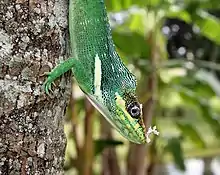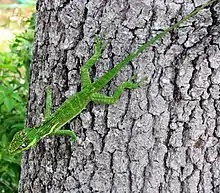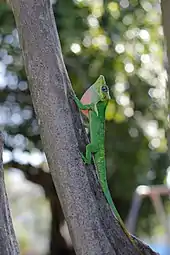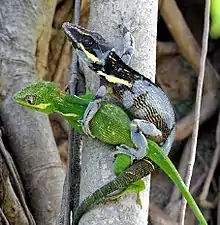Knight anole
The knight anole (Anolis equestris) is the largest species of anole (US: /əˈnoʊ.li/ ⓘ) in the Dactyloidae family.[1] Other common names include Cuban knight anole or Cuban giant anole, highlighting its native country, but it has also been introduced to Florida.[2] In its native Cuba, this large anole is called chupacocote.[3]
| Knight anole | |
|---|---|
 | |
 | |
| Scientific classification | |
| Domain: | Eukaryota |
| Kingdom: | Animalia |
| Phylum: | Chordata |
| Class: | Reptilia |
| Order: | Squamata |
| Suborder: | Iguania |
| Family: | Dactyloidae |
| Genus: | Anolis |
| Species: | A. equestris |
| Binomial name | |
| Anolis equestris Merrem, 1820 | |
| Synonyms | |
|
Deiroptyx equestris | |
Taxonomy
The knight anole is part of a group of overall similar (in both appearance and behavior, all are crown-giant ecomorphs) anoles from Cuba known as the equestris species complex, including A. baracoae, A. luteogularis, A. noblei, A. pigmaequestris and A. smallwoodi.[4]
These and a few other anole species from Cuba, Hispaniola and Puerto Rico are sometimes placed in their own genus, Deiroptyx.[4]
Geographic range and habitat
Knight anoles are native to Cuba, but have been widely introduced into South Florida, where they reproduce and spread readily as an invasive species.[2][5] They cannot withstand cold temperatures; in winter freezes in Florida, they have been known to fall to the ground from tree canopies, similarly to the green iguana.[5] In highland parts of its native Cuba, a few individuals may rest adjacent to each other during the relatively cold winters (otherwise the species is solitary and highly territorial).[6]
In Cuba they can be seen from near sea level to an altitude of 3,300 ft (1,000 m) in a wide range of habitats with trees, such as forest, mangrove, savanna, cultivated areas and gardens.[5] In its introduced Florida range it even occurs in trees along roads in Miami.[2] Knight anoles are arboreal, mostly found high in trees on the trunk or branches in the canopy, but will descend to the ground to get from one tree to another, or for thermoregulation,[5] when occasionally seen on warm asphalt, rocks, or sidewalks.
Appearance

Adult knight anoles are about 13–20 in (33–51 cm) in total length, including their tail that is longer than the head-and-body,[2] and weigh 0.56–4.83 oz (16–137 g).[5][7] Males grow larger than females, with adults of the former having a snout–vent length of 3.9–7.5 in (10–19 cm) and the latter 3.5–6.3 in (9–16 cm).[5] It is mostly bright green with a yellow stripe on the side of the head and another on the shoulder, but it is able to perform some color changes.[2][5] It has a pinkish-white dewlap. Juveniles have light bands on the body.[5]
Behavior

Knight anoles are diurnal and fiercely territorial.[5] Initially they turn to face almost any perceived threat, if only from a distance. During its challenge display, a lizard will sit high on all fours, gape menacingly, turn green, and perhaps bob its head. The male will extend its dewlap, and both females and males will "puff themselves up" with air.
Diet
When young, its diet consists mainly of insects. As an adult, it mostly eats invertebrates (notably insects and snails), but regularly take fruits and can function as a seed disperser.[8][9] They may also take small vertebrates prey such as small birds and reptiles (including other anoles), but studies indicate that they do this less frequently than several other anole species.[7][8][9]
Captivity
In captivity, the anole's aggressiveness seems to lessen to a certain degree; if it is raised from the time of its birth and handled, it is common for it to become tame enough to be held. In communal terraria with other species of lizards, it rarely attacks smaller lizards, unless the other reptile intrudes on its territory. It may be hand-fed with caution, since it has a strong bite and many small, sharp teeth.
See also
References
- Bartlett, R.D.; P. P. Bartlett (2008). Anoles, Basilisks, and Water Dragons. pp. 71, 75. ISBN 978-0764137754.
- Conant, R.; J.T. Collins (1998). A Field Guide to the Reptiles and Amphibians of Eastern and Central North America (3 ed.). pp. 208–215. ISBN 978-0395904527.
- "Guía Elemental - Santiago de Cuba Anfibios y Reptiles de la Reserva de la Biosfera BACONAO" (PDF). Fieldguides.fieldmuseum.org. Retrieved 22 March 2022.
- Kristen A. Nicholson; Brian I. Crother; Craig Guyer; Jay M. Savage (10 September 2012). "It is time for a new classification of anoles (Squamata: Dactyloidae)". Zootaxa. 3477: 1–108. doi:10.11646/zootaxa.3477.1.1.
- Camposano; Krysko; Enge; Donlan; Granatosky (2008). "The Knight Anole (Anolis equestris) in Florida". Iguana. 15 (4): 212–219.
- Marrero, R.; Torres, T.; Rodríguez-Cabrera, T.M. (2016). "Winter aggregation in Anolis equestris and A. lucius (Squamata: Dactyloidae), two territorial species from Cuba". Phyllomedusa. 15 (2): 181–186. doi:10.11606/issn.2316-9079.v15i2p181-186.
- Kirsten E. Nicholson and Paul M. Richards (2011). Home-range size and overlap within an introduced population of the Cuban knight anole, Anolis equestris (Squamata: Iguanidae) Phyllomedusa, 10 (1), 65-73
- Dalrymple, G.H. (1980). "Comments on the Density and Diet of a Giant Anole Anolis equestris". Journal of Herpetology. 14 (4): 412–415. doi:10.2307/1563699. JSTOR 1563699.
- Giery; Vezzani; Zona; Stroud (2017). "Frugivory and seed dispersal by the invasive knight anole (Anolis equestris) in Florida, USA". Food Webs. 11: 13–16. doi:10.1016/j.fooweb.2017.05.003.
